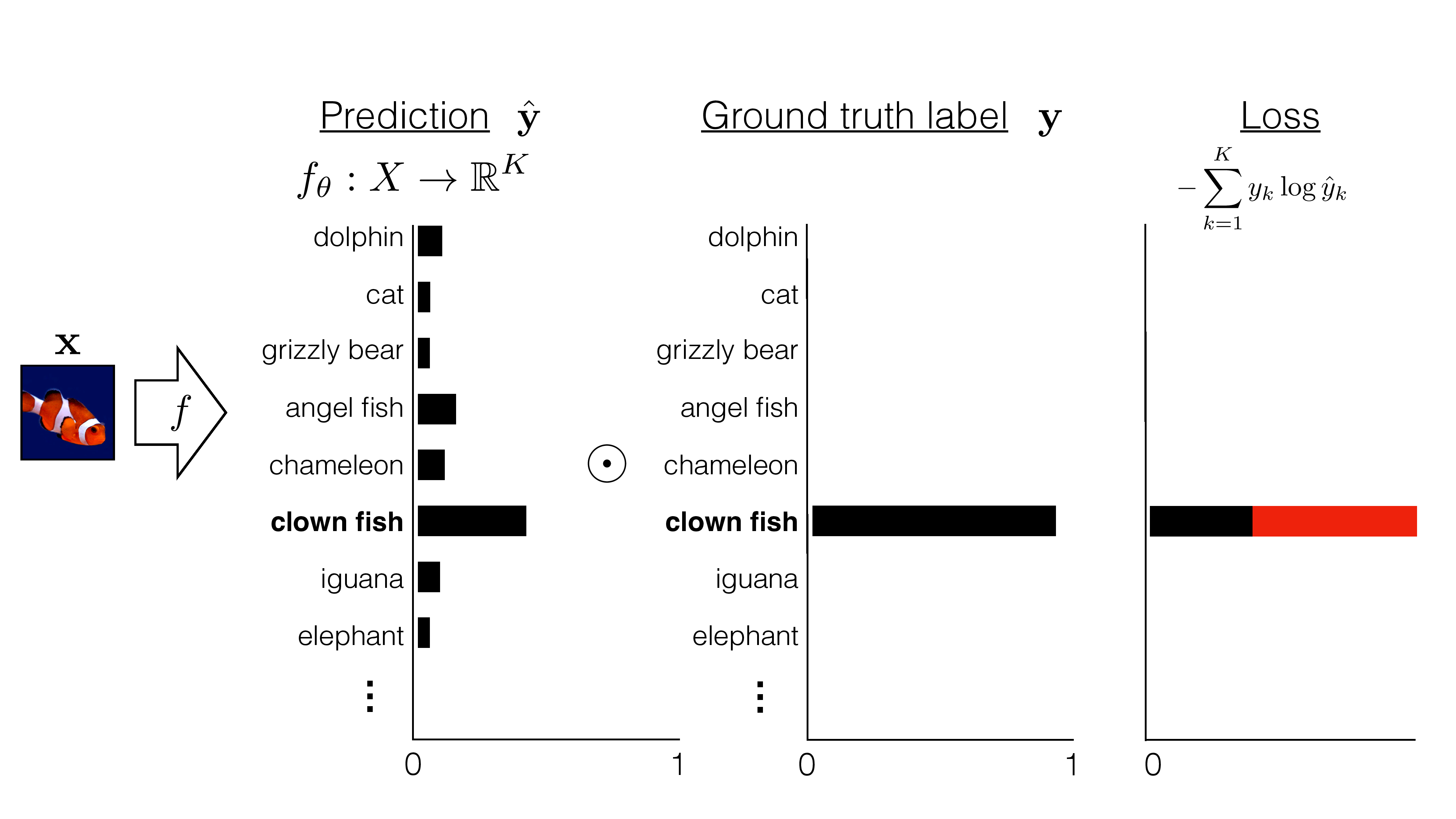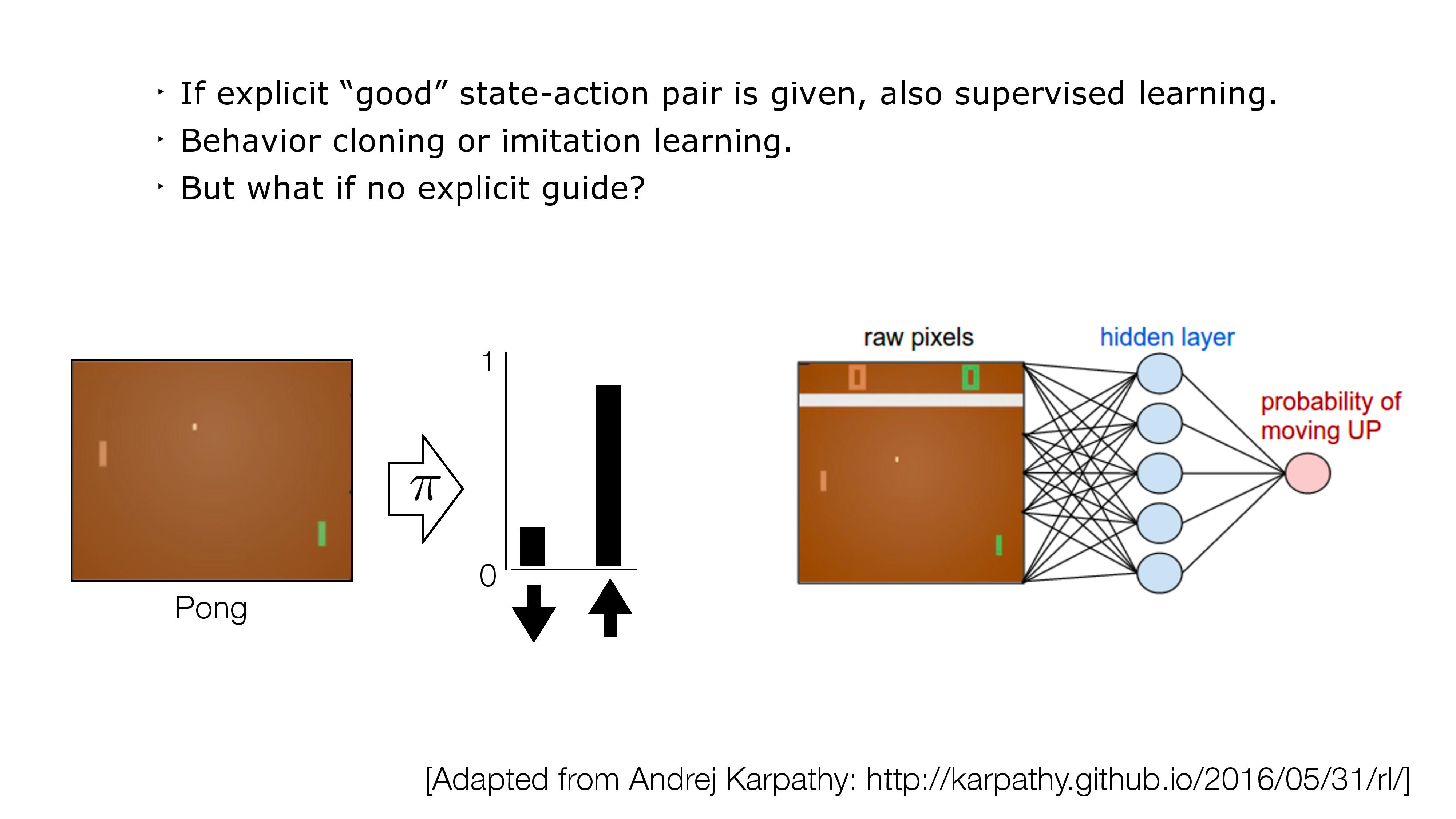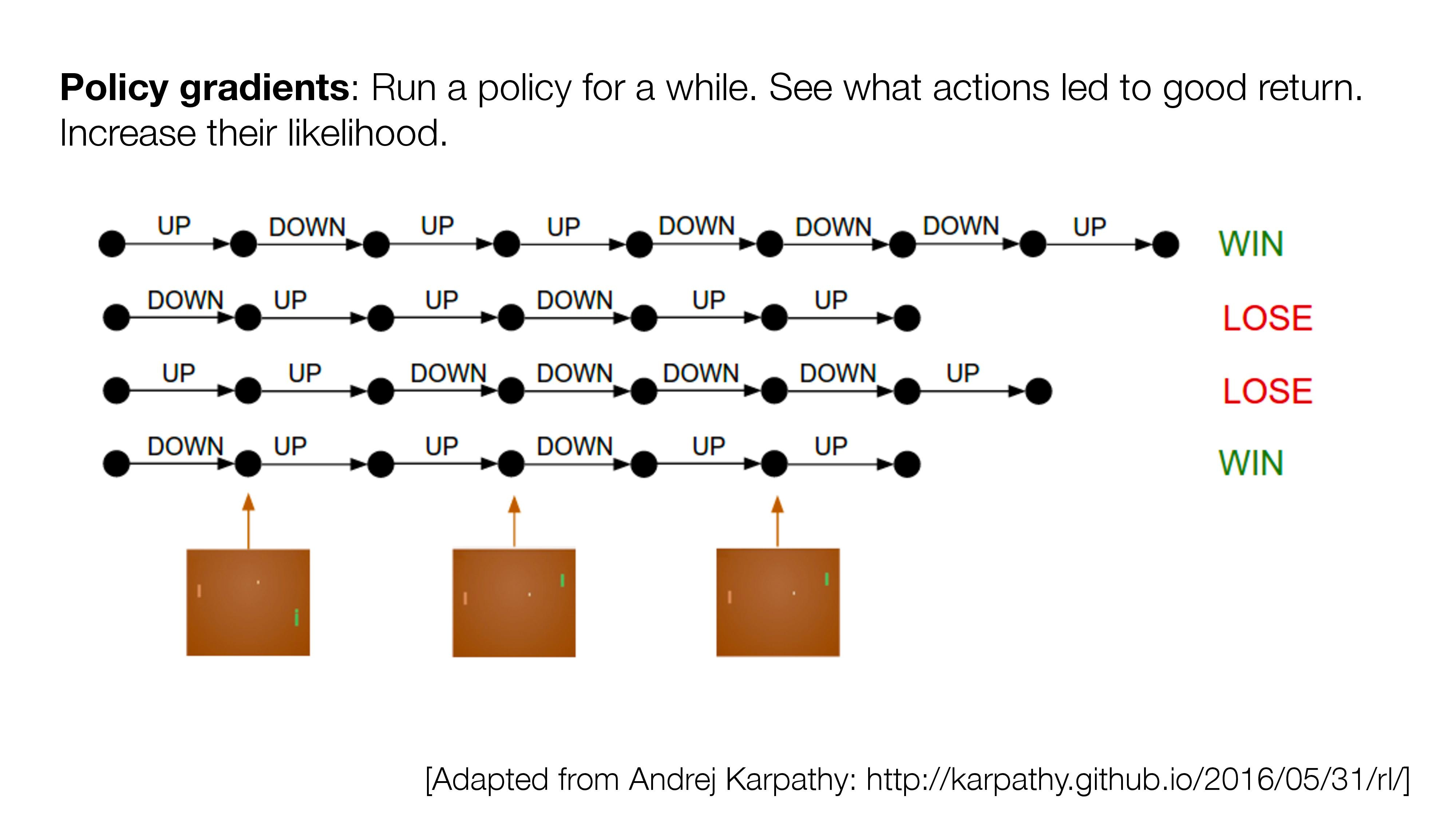
Intro to Machine Learning


Lecture 11: Reinforcement Learning
Shen Shen
April 26, 2024
Outline
- Recap: Markov Decision Processes
- Reinforcement Learning Setup
- What's changed from MDP?
- Model-based methods
- Model-free methods
- (tabular) Q-learning
- \(\epsilon\)-greedy action selection
- exploration vs. exploitation
- (neural network) Q-learning
- (tabular) Q-learning
- RL setup again
- What's changed from supervised learning?
MDP Definition and Goal
- \(\mathcal{S}\) : state space, contains all possible states \(s\).
- \(\mathcal{A}\) : action space, contains all possible actions \(a\).
- \(\mathrm{T}\left(s, a, s^{\prime}\right)\) : the probability of transition from state \(s\) to \(s^{\prime}\) when action \(a\) is taken.
- \(\mathrm{R}(s, a)\) : a function that takes in the (state, action) and returns a reward.
- \(\gamma \in [0,1]\): discount factor, a scalar.
- \(\pi{(s)}\) : policy, takes in a state and returns an action.
Ultimate goal of an MDP: Find the "best" policy \(\pi\).
State \(s\)
Action \(a\)
Reward \(r\)




























Policy \(\pi(s)\)
Transition \(\mathrm{T}\left(s, a, s^{\prime}\right)\)
Reward \(\mathrm{R}(s, a)\)
time

a trajectory (aka an experience or rollout) \(\quad \tau=\left(s_0, a_0, r_0, s_1, a_1, r_1, \ldots\right)\)
how "good" is a trajectory?
- almost all transitions are deterministic:
-
Normally, actions take Mario to the “intended” state.
-
E.g., in state (7), action “↑” gets to state (4)
-
-
If an action would've taken us out of this world, stay put
-
E.g., in state (9), action “→” gets back to state (9)
-
-
except, in state (6), action “↑” leads to two possibilities:
-
20% chance ends in (2)
-
80% chance ends in (3)
-
-
Running example: Mario in a grid-world

- 9 possible states
- 4 possible actions: {Up ↑, Down ↓, Left ←, Right →}

example cont'd

- (state, action) pair can get Mario rewards:
- Any other (state, action) pairs get reward 0
- In state (6), any action gets reward -10
- In state (3), any action gets reward +1
actions: {Up ↑, Down ↓, Left ←, Right →}
- goal is to find a gameplay policy strategy for Mario, to get maximum expected sum of discounted rewards, with a discount facotor \(\gamma = 0.9\)
Now, let's think about \(V_\pi^3(6)\)
Recall:
\(\pi(s) = ``\uparrow",\ \forall s\)
\(\mathrm{R}(3, \uparrow) = 1\)
\(\mathrm{R}(6, \uparrow) = -10\)
\(\gamma = 0.9\)
2
3
action \(\uparrow\)
action \(\uparrow\)
6
action \(\uparrow\)
2
action \(\uparrow\)
3
action \(\uparrow\)
MDP
Policy evaluation
finite-horizon policy evaluation
infinite-horizon policy evaluation
\(\gamma\) is now necessarily <1 for convergence too in general
Bellman equation
- \(|\mathcal{S}|\) many linear equations
For any given policy \(\pi(s),\) the infinite-horizon (state) value functions are
\(V_\pi(s):=\mathbb{E}\left[\sum_{t=0}^{\infty} \gamma^t \mathrm{R}\left(s_t, \pi\left(s_t\right)\right) \mid s_0=s, \pi\right], \forall s\)
For a given policy \(\pi(s),\) the finite-horizon horizon-\(h\) (state) value functions are:
\(V^h_\pi(s):=\mathbb{E}\left[\sum_{t=0}^{h-1} \gamma^t \mathrm{R}\left(s_t, \pi\left(s_t\right)\right) \mid s_0=s, \pi\right], \forall s\)
Bellman recursion
Recall:

example: recursively finding \(Q^h(s, a)\)
\(\gamma = 0.9\)
\(Q^h(s, a)\) is the expected sum of discounted rewards for
States and one special transition:
\(\mathrm{R}(s,a)\)
- starting in state \(s\),
- take action \(a\), for one step
- act optimally there afterwards for the remaining \((h-1)\) steps
Recall:

\(\gamma = 0.9\)
\(Q^h(s, a)\) is the expected sum of discounted rewards for
- starting in state \(s\),
- take action \(a\), for one step
- act optimally there afterwards for the remaining \((h-1)\) steps
States and one special transition:
- act optimally for one more timestep, at the next state \(s^{\prime}\)
- 20% chance, \(s'\) = 2, act optimally, receive \(\max _{a^{\prime}} Q^{1}\left(2, a^{\prime}\right)\)
- 80% chance, \(s'\) = 3, act optimally, receive \(\max _{a^{\prime}} Q^{1}\left(3, a^{\prime}\right)\)
Let's consider \(Q^2(6, \uparrow)\)
\(= -10 + .9 [.2*0+ .8*1] = -9.28\)
\(=\mathrm{R}(6,\uparrow) + \gamma[.2 \max _{a^{\prime}} Q^{1}\left(2, a^{\prime}\right)+ .8\max _{a^{\prime}} Q^{1}\left(3, a^{\prime}\right)] \)
- receive \(\mathrm{R}(6,\uparrow)\)
Recall:

\(\gamma = 0.9\)
\(Q^h(s, a)\) is the expected sum of discounted rewards for
- starting in state \(s\),
- take action \(a\), for one step
- act optimally there afterwards for the remaining \((h-1)\) steps
States and one special transition:
\(Q^2(6, \uparrow) =\mathrm{R}(6,\uparrow) + \gamma[.2 \max _{a^{\prime}} Q^{1}\left(2, a^{\prime}\right)+ .8\max _{a^{\prime}} Q^{1}\left(3, a^{\prime}\right)] \)
in general
Recall:

\(\gamma = 0.9\)
\(Q^h(s, a)\) is the expected sum of discounted rewards for
- starting in state \(s\),
- take action \(a\), for one step
- act optimally there afterwards for the remaining \((h-1)\) steps
States and one special transition:
what's the optimal action in state 3, with horizon 2, given by \(\pi_2^*(3)=?\)
in general
either up or right
Given the finite horizon recursion
- for \(s \in \mathcal{S}, a \in \mathcal{A}\) :
- \(\mathrm{Q}_{\text {old }}(\mathrm{s}, \mathrm{a})=0\)
- while True:
- for \(s \in \mathcal{S}, a \in \mathcal{A}\) :
- \(\mathrm{Q}_{\text {new }}(s, a) \leftarrow \mathrm{R}(s, a)+\gamma \sum_{s^{\prime}} \mathrm{T}\left(s, a, s^{\prime}\right) \max _{a^{\prime}} \mathrm{Q}_{\text {old }}\left(s^{\prime}, a^{\prime}\right)\)
- if \(\max _{s, a}\left|Q_{\text {old }}(s, a)-Q_{\text {new }}(s, a)\right|<\epsilon:\)
- return \(\mathrm{Q}_{\text {new }}\)
- \(\mathrm{Q}_{\text {old }} \leftarrow \mathrm{Q}_{\text {new }}\)
We should easily be convinced of the infinite horizon equation
Infinite-horizon Value Iteration
Outline
- Recap: Markov Decision Processes
- Reinforcement Learning Setup
- What's changed from MDP?
- Model-based methods
- Model-free methods
- (tabular) Q-learning
- \(\epsilon\)-greedy action selection
- exploration vs. exploitation
- (neural network) Q-learning
- (tabular) Q-learning
- RL setup again
- What's changed from supervised learning?
- all transitions probabilities are unknown.
Running example: Mario in a grid-world (the Reinforcement-Learning Setup)

- 9 possible states
- 4 possible actions: {Up ↑, Down ↓, Left ←, Right →}
- (state, action) pair gets Mario unknown rewards.
- goal is to find a gameplay policy strategy for Mario, to get maximum expected sum of discounted rewards, with a discount facotor \(\gamma = 0.9\)
MDP Definition and Goal
- \(\mathcal{S}\) : state space, contains all possible states \(s\).
- \(\mathcal{A}\) : action space, contains all possible actions \(a\).
- \(\mathrm{T}\left(s, a, s^{\prime}\right)\) : the probability of transition from state \(s\) to \(s^{\prime}\) when action \(a\) is taken.
- \(\mathrm{R}(s, a)\) : a function that takes in the (state, action) and returns a reward.
- \(\gamma \in [0,1]\): discount factor, a scalar.
- \(\pi{(s)}\) : policy, takes in a state and returns an action.
Ultimate goal of an MDP: Find the "best" policy \(\pi\).
RL
RL:
Outline
- Recap: Markov Decision Processes
- Reinforcement Learning Setup
- What's changed from MDP?
- Model-based methods
- Model-free methods
- (tabular) Q-learning
- \(\epsilon\)-greedy action selection
- exploration vs. exploitation
- (neural network) Q-learning
- (tabular) Q-learning
- RL setup again
- What's changed from supervised learning?
Model-Based Methods
Keep playing the game to approximate the unknown rewards and transitions.
e.g. by observing what reward \(r\) received from being in state 6 and take \(\uparrow\) action, we know \(\mathrm{R}(6,\uparrow)\)
Transitions are a bit more involved but still simple:
Rewards are particularly easy:
e.g. play the game 1000 times, count the # of times (we started in state 6, take \(\uparrow\) action, end in state 2), then, roughly, \(\mathrm{T}(6,\uparrow, 2 ) = (\text{that count}/1000) \)
(MDP)-
Now, with \(\mathrm{R}, \mathrm{T}\) estimated, we're back in MDP setting.
(for solving RL)
In Reinforcement Learning:
- Model typically means MDP tuple \(\langle\mathcal{S}, \mathcal{A}, \mathrm{T}, \mathrm{R}, \gamma\rangle\)
- The learning objective is not referred to as hypothesis explicitly, we simply just call it the policy.
Outline
- Recap: Markov Decision Processes
- Reinforcement Learning Setup
- What's changed from MDP?
- Model-based methods
- Model-free methods
- (tabular) Q-learning
- \(\epsilon\)-greedy action selection
- exploration vs. exploitation
- (neural network) Q-learning
- (tabular) Q-learning
- RL setup again
- What's changed from supervised learning?

How do we learn a good policy without learning transition or rewards explicitly?
We kinda already know a way: Q functions!
So once we have "good" Q values, we can find optimal policy easily.
(Recall from MDP lab)
But didn't we calculate this Q-table via value iteration using transition and rewards explicitly?
Indeed, recall that, in MDP:
- for \(s \in \mathcal{S}, a \in \mathcal{A}\) :
- \(\mathrm{Q}_{\text {old }}(\mathrm{s}, \mathrm{a})=0\)
- while True:
- for \(s \in \mathcal{S}, a \in \mathcal{A}\) :
- \(\mathrm{Q}_{\text {new }}(s, a) \leftarrow \mathrm{R}(s, a)+\gamma \sum_{s^{\prime}} \mathrm{T}\left(s, a, s^{\prime}\right) \max _{a^{\prime}} \mathrm{Q}_{\text {old }}\left(s^{\prime}, a^{\prime}\right)\)
- if \(\max _{s, a}\left|Q_{\text {old }}(s, a)-Q_{\text {new }}(s, a)\right|<\epsilon:\)
- return \(\mathrm{Q}_{\text {new }}\)
- \(\mathrm{Q}_{\text {old }} \leftarrow \mathrm{Q}_{\text {new }}\)
- Infinite horizon equation
- Infinite-horizon Value Iteration
- Finite horizon recursion
- value iteration relied on having full access to \(\mathrm{R}\) and \(\mathrm{T}\)
- BUT, this is basically saying the realized \(s'\) is the only possible next state; pretty rough! We'd override any previous "learned" Q values.
- hmm... perhaps, we could simulate \((s,a)\), observe \(r\) and \(s'\), and just use
- better way is to smoothly keep track of what's our old belief with new evidence:
e.g.
as the proxy for the r.h.s. assignment?
target
old belief
learning rate
- for \(s \in \mathcal{S}, a \in \mathcal{A}\) :
- \(\mathrm{Q}_{\text {old }}(\mathrm{s}, \mathrm{a})=0\)
- while True:
- for \(s \in \mathcal{S}, a \in \mathcal{A}\) :
- \(\mathrm{Q}_{\text {new }}(s, a) \leftarrow \mathrm{R}(s, a)+\gamma \sum_{s^{\prime}} \mathrm{T}\left(s, a, s^{\prime}\right) \max _{a^{\prime}} \mathrm{Q}_{\text {old }}\left(s^{\prime}, a^{\prime}\right)\)
- if \(\max _{s, a}\left|Q_{\text {old }}(s, a)-Q_{\text {new }}(s, a)\right|<\epsilon:\)
- return \(\mathrm{Q}_{\text {new }}\)
- \(\mathrm{Q}_{\text {old }} \leftarrow \mathrm{Q}_{\text {new }}\)
VALUE-ITERATION \((\mathcal{S}, \mathcal{A}, \mathrm{T}, \mathrm{R}, \gamma, \epsilon)\)
Q-LEARNING \(\left(\mathcal{S}, \mathcal{A}, \gamma, \mathrm{s}_0,\alpha\right)\)
- for \(s \in \mathcal{S}, a \in \mathcal{A}\) :
- \(\mathrm{Q}_{\text {old }}(\mathrm{s}, \mathrm{a})=0\)
- \(s \leftarrow s_0\)
- while True:
- \(a \leftarrow \) select_action \(\left(s, Q_{\text{old}}(s, a)\right)\)
- \(r, s^{\prime}=\operatorname{execute}(a)\)
- \(\mathrm{Q}_{\text {new}}(s, a) \leftarrow(1-\alpha) \mathrm{Q}_{\text {old }}(s, a)+\alpha\left(r+\gamma \max _{a^{\prime}} \mathrm{Q}_{\text {old}}(s', a')\right)\)
- \(s \leftarrow s^{\prime}\)
- if \(\max _{s, a}\left|Q_{\text {old }}(s, a)-Q_{\text {new }}(s, a)\right|<\epsilon:\)
- return \(\mathrm{Q}_{\text {new }}\)
- \(\mathrm{Q}_{\text {old }} \leftarrow \mathrm{Q}_{\text {new }}\)
"calculating"
"estimating"
Q-LEARNING \(\left(\mathcal{S}, \mathcal{A}, \gamma, \mathrm{s}_0,\alpha\right)\)
- for \(s \in \mathcal{S}, a \in \mathcal{A}\) :
- \(\mathrm{Q}_{\text {old }}(\mathrm{s}, \mathrm{a})=0\)
- \(s \leftarrow s_0\)
- while True:
- \(a \leftarrow \) select_action \(\left(s, Q_{\text{old}}(s, a)\right)\)
- \(r, s^{\prime}=\operatorname{execute}(a)\)
- \(\mathrm{Q}_{\text {new}}(s, a) \leftarrow(1-\alpha) \mathrm{Q}_{\text {old }}(s, a)+\alpha\left(r+\gamma \max _{a^{\prime}} \mathrm{Q}_{\text {old}}(s', a')\right)\)
- \(s \leftarrow s^{\prime}\)
- if \(\max _{s, a}\left|Q_{\text {old }}(s, a)-Q_{\text {new }}(s, a)\right|<\epsilon:\)
- return \(\mathrm{Q}_{\text {new }}\)
- \(\mathrm{Q}_{\text {old }} \leftarrow \mathrm{Q}_{\text {new }}\)
- Remarkably, still can converge. (So long \(\mathcal{S}, \mathcal{A}\) are finite; we visit every state and action infinity-many times; and \(\alpha\) decays.
- Line 7 :
\(\mathrm{Q}_{\text {new}}(s, a) \leftarrow\mathrm{Q}_{\text {old }}(s, a)+\alpha\left([r+\gamma \max _{a^{\prime}} \mathrm{Q}_{\text {old}}(s', a')] - \mathrm{Q}_{\text {old }}(s, a)\right)\)
is equivalently:
old belief
learning
rate
target
old belief
- Line 5, a sub-routine.
pretty similar to SGD.
- \(\epsilon\)-greedy action selection strategy:
- with probability \(1-\epsilon\), choose \(\arg \max _{\mathrm{a}} \mathrm{Q}(s, \mathrm{a})\)
- with probability \(\epsilon\), choose an action \(a \in \mathcal{A}\) uniformly at random
- If our \(Q\) values are estimated quite accurately (nearly converged to the true \(Q\) values), then should act greedily
- \(\arg \max _a Q^h(s, a),\) as we did in MDP.
- During learning, especially in early stages, we'd like to explore.
- Benefit: get to observe more diverse (s,a) consequences.
- exploration vs. exploitation.
Outline
- Recap: Markov Decision Processes
- Reinforcement Learning Setup
- What's changed from MDP?
- Model-based methods
- Model-free methods
- (tabular) Q-learning
- \(\epsilon\)-greedy action selection
- exploration vs. exploitation
- (neural network) Q-learning
- (tabular) Q-learning
- RL setup again
- What's changed from supervised learning?
- Q-learning only is kinda sensible for tabular setting.
- What do we do if \(\mathcal{S}\) and/or \(\mathcal{A}\) are large (or continuous)?
- Recall from Q-learning algorithm, key line 7 :
is equivalently:
\(\mathrm{Q}_{\text {new}}(s, a) \leftarrow\mathrm{Q}_{\text {old }}(s, a)+\alpha\left([r+\gamma \max _{a^{\prime}} \mathrm{Q}_{\text {old}}(s', a')] - \mathrm{Q}_{\text {old }}(s, a)\right)\)
learning
rate
old belief
target
old belief
- Can be interpreted as we're minimizing:
\(\left(Q(s, a)-\left(r+\gamma \max _{a^{\prime}} Q\left(s^{\prime}, a^{\prime}\right)\right)\right)^2\)
via gradient method!
Outline
- Recap: Markov Decision Processes
- Reinforcement Learning Setup
- What's changed from MDP?
- Model-based methods
- Model-free methods
- (tabular) Q-learning
- \(\epsilon\)-greedy action selection
- exploration vs. exploitation
- (neural network) Q-learning
- (tabular) Q-learning
- RL setup again
- What's changed from supervised learning?

Supervised learning


- If no direct supervision is available?
- Strictly RL setting. Interact, observe and get data. Use rewards/value as "coy" supervision signal.
Thanks!
We'd appreciate your feedback on the lecture.